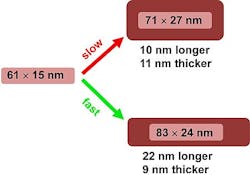Technique can control gold nanorods' optical properties, enabling biomedical utilities
North Carolina State University (Raleigh, NC) researchers have a developed a technique for efficiently producing gold nanorods in large quantities while simultaneously controlling their dimensions and optical properties. The work could find utilities in biomedical imaging and cancer treatment, among others.
Related: Nanorods detect DNA traces with higher sensitivity
The research team—led by Dr. Joseph Tracy, an associate professor of materials science and engineering at NC State—started with an existing technique in which gold nanorods are formed by mixing two chemical solutions together. However, that technique only converts 30 percent of the gold into nanorods—the rest remains dissolved in solution.
To convert the remaining 70 percent of the gold into nanorods, the researchers added a continuous stream of ascorbic acid (known as vitamin C) to the solution, while constantly stirring the mixture. The ascorbic acid essentially pulls the gold out of the solution and deposits it on the existing nanorods.
But the researchers also found that the slower they added the ascorbic acid, the stubbier the nanorods became. This is important because the optical properties of gold nanorods depend on their aspect ratio (relative height and width). For example, long, thin gold nanorods absorb light at wavelengths greater than 800 nm (near-infrared), while shorter, wider gold nanorods absorb light at wavelengths below 700 nm (red or dark red).
"The ability to fine-tune these optical properties will likely be useful for the development of new biomedical applications," Tracy says.
Full details of the work appear online in the journal Chemistry of Materials; for more information, please visit http://pubs.acs.org/doi/abs/10.1021/cm402277y.
-----
Follow us on Twitter, 'like' us on Facebook, and join our group on LinkedIn
Subscribe now to BioOptics World magazine; it's free!
